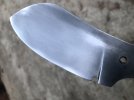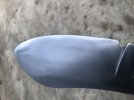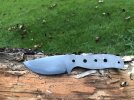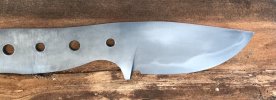ScarFoot
Knifemaker / Craftsman / Service Provider
- Joined
- Sep 16, 2021
- Messages
- 769
I’m new to making knives and not sure what happened with this hamon. I had the clay 0.5”-0.75” from the edge but the hamon line is right at the edge. The pictures show what it looked like after the first few cleaning passes post quench and temper. You can see a faint line where I thought the hamon should be. Any thoughts? I’m not going to lie I don’t remember if it’s 1075 or 1084. I just grabbed a piece and started grinding.









